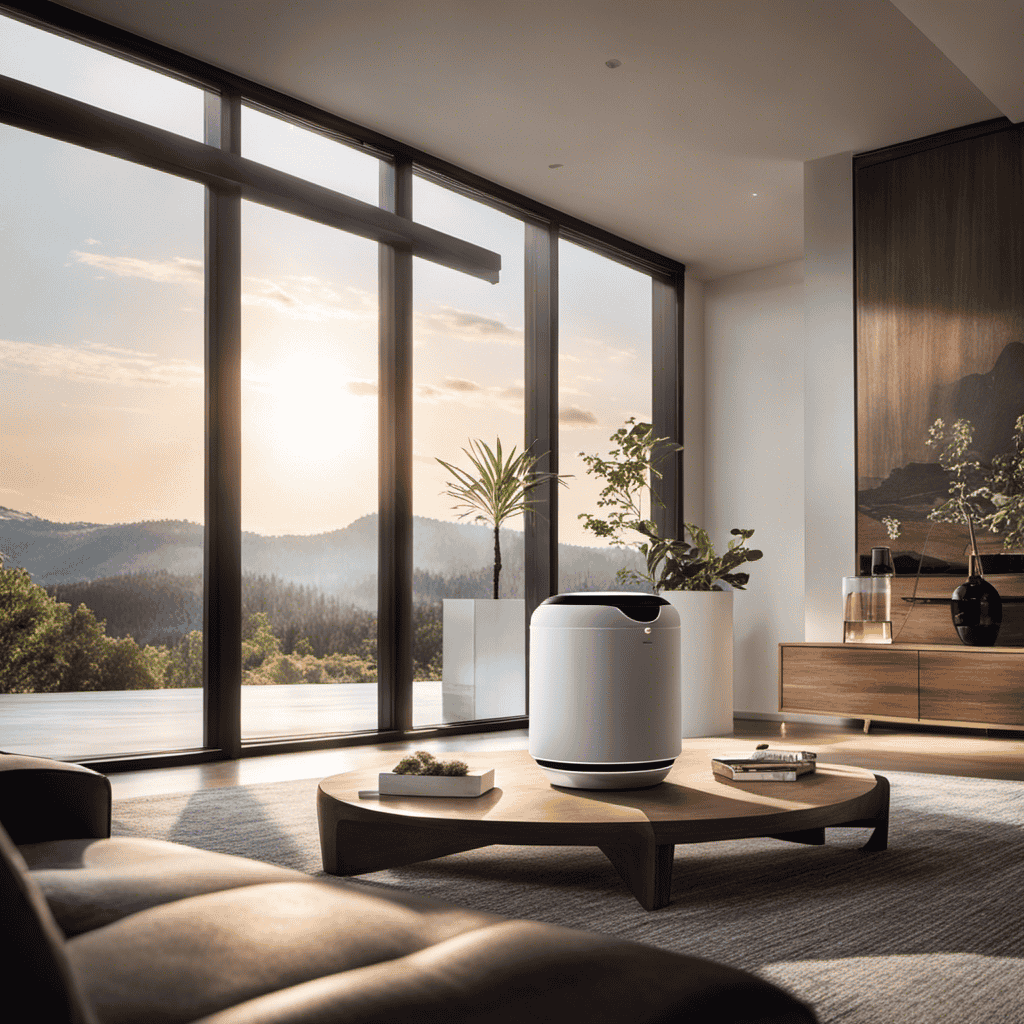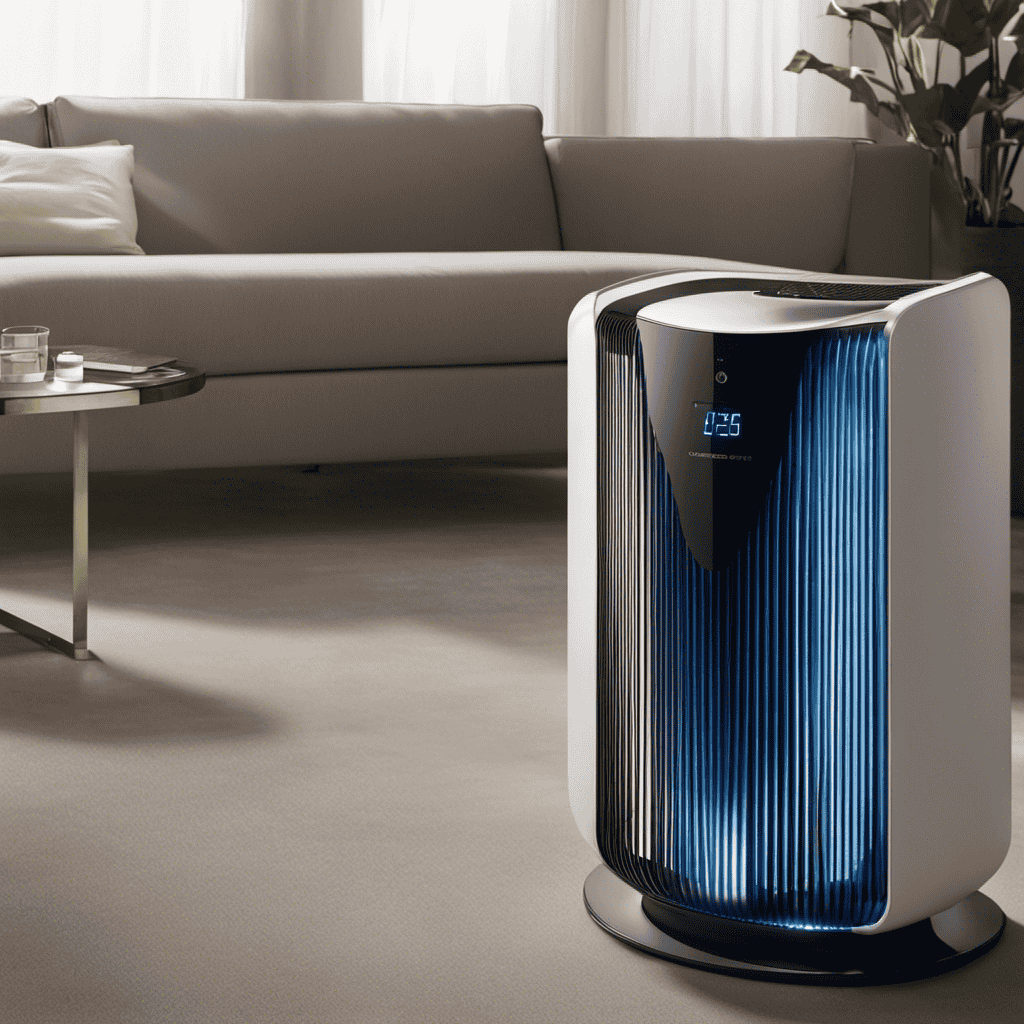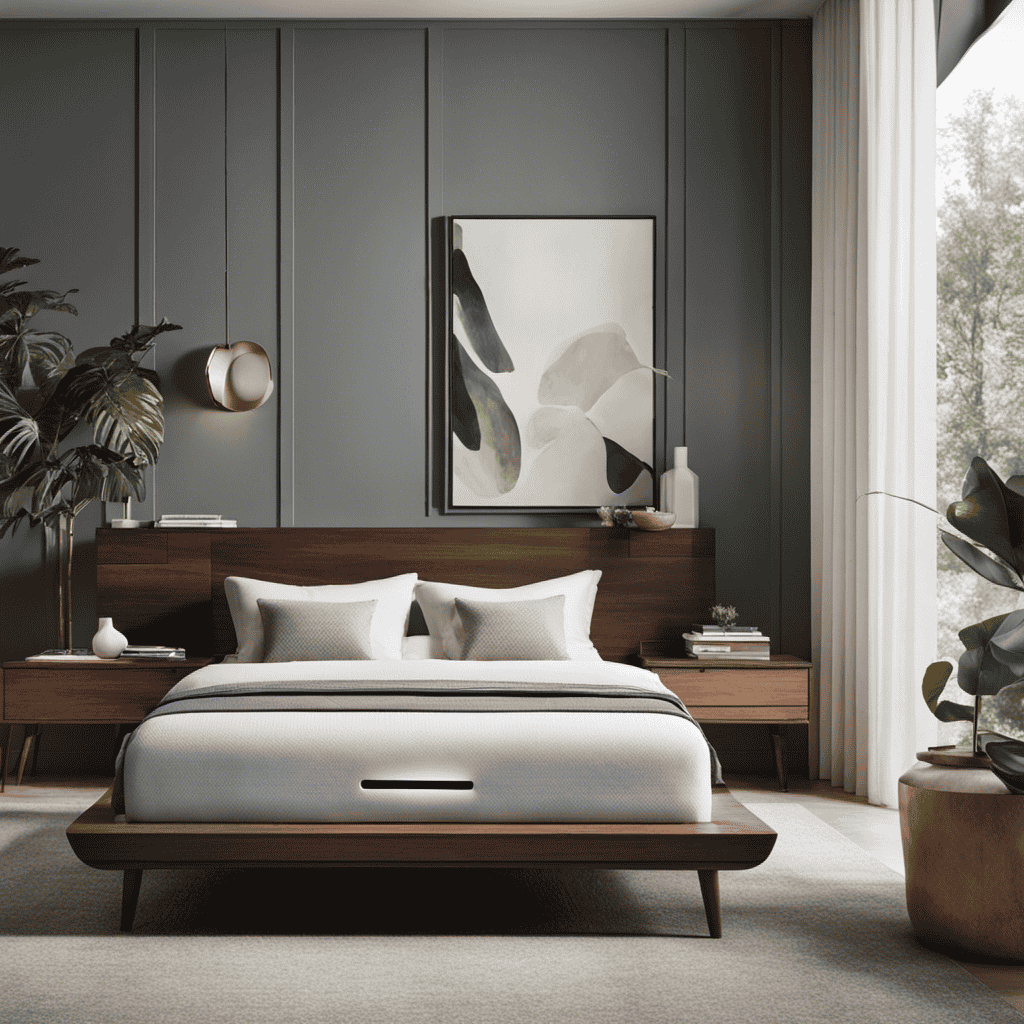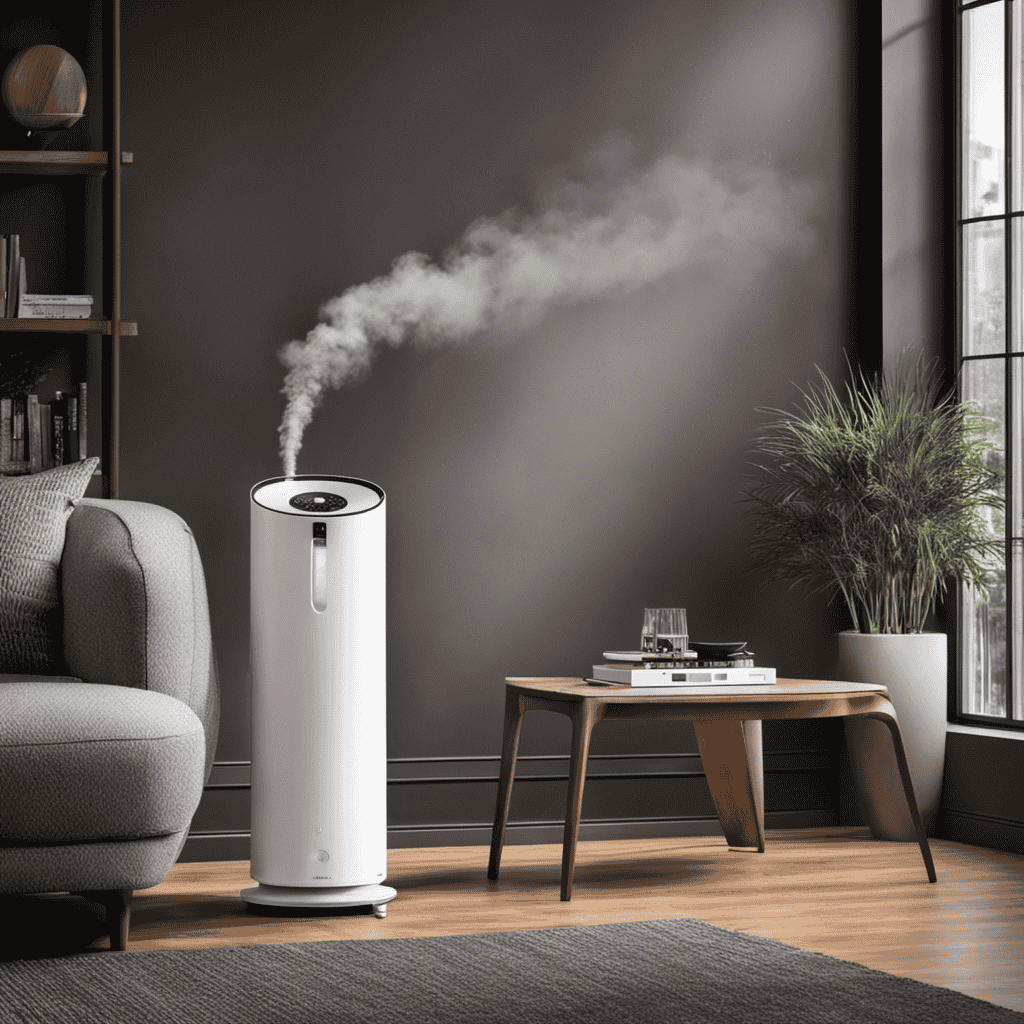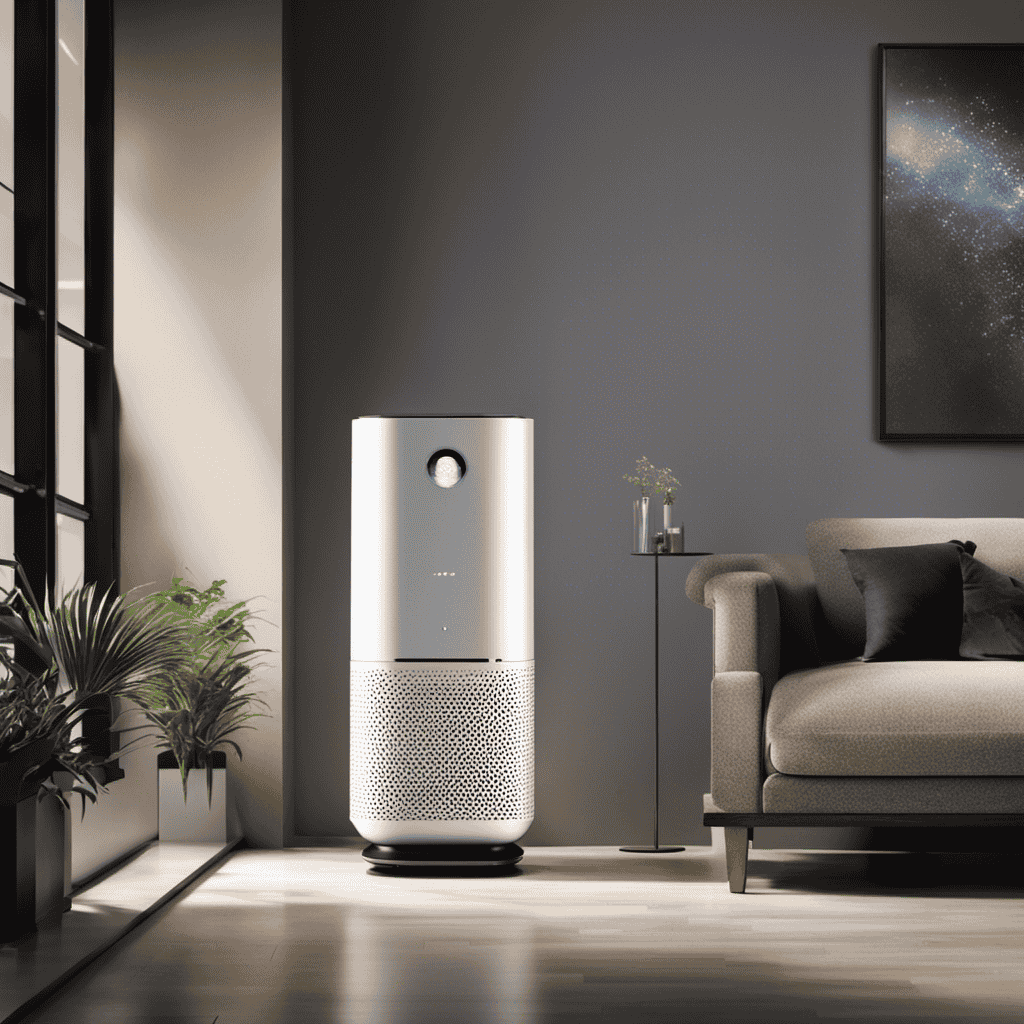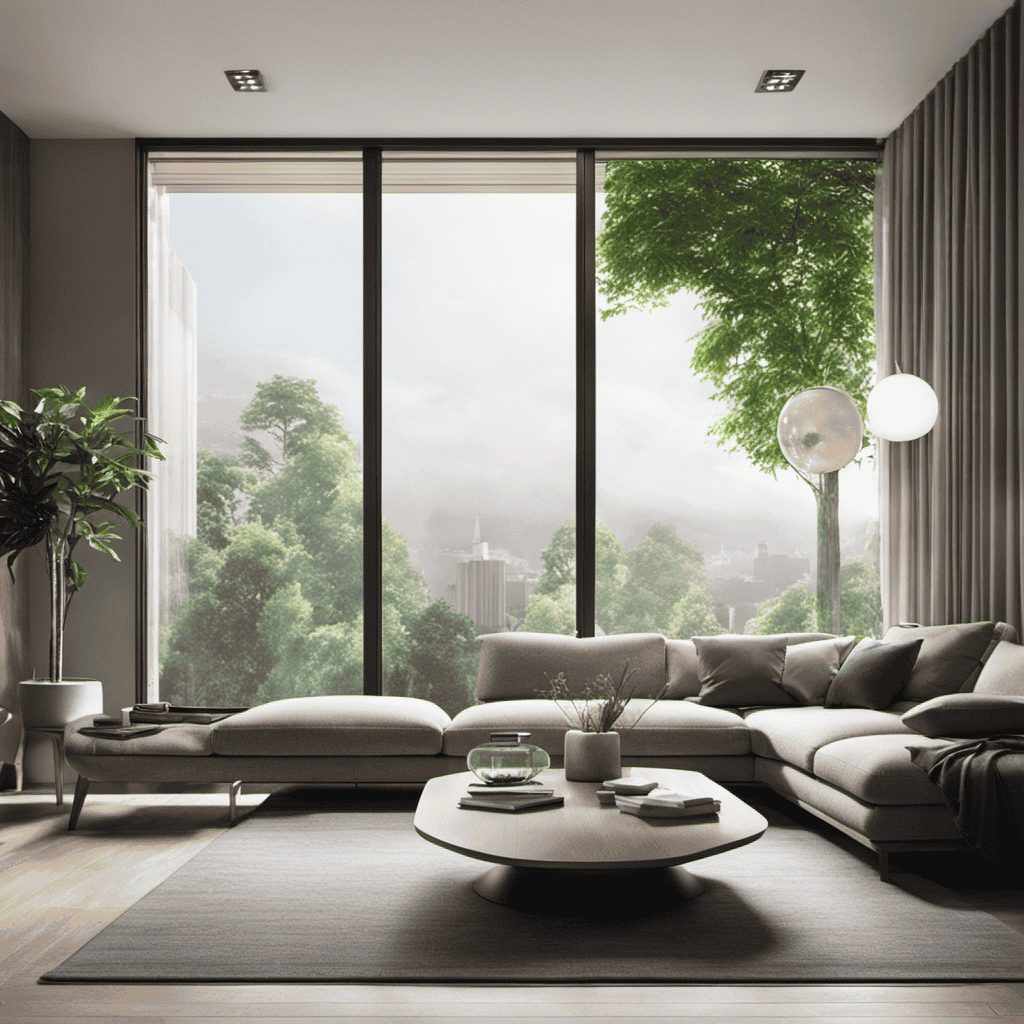As a consumer looking for the ideal air purifier, I often feel inundated with the numerous options out there. Nevertheless, by knowing what to consider, I can make a well-informed choice and guarantee that the air in my home is pure and healthy.
In this article, I will delve into the key factors to consider when choosing an air purifier, such as filter types, CADR ratings, coverage area, noise level, energy efficiency, maintenance, brand reputation, price range, and warranty.
Let’s dive in and discover the best air purifier for your needs.
Key Takeaways
- Choosing the right filter type is crucial for eliminating specific contaminants and improving air quality.
- Consider the CADR rating and air quality sensors to ensure efficient removal of pollutants and real-time feedback on air quality.
- Check the coverage area, noise level, and energy efficiency of the air purifier to match the size of the room and create a peaceful environment.
- Select an air purifier with smart features and a HEPA filter to control it remotely, monitor air quality, and effectively remove allergens for better respiratory health.
Filter Types
When choosing an air purifier, you should consider the different filter types available. The effectiveness of an air purifier largely depends on the type of filter it uses. Over the years, there have been significant advancements in filter technology, resulting in more efficient and effective air purification.
One of the most common types of filters is the High-Efficiency Particulate Air (HEPA) filter. HEPA filters are capable of trapping up to 99.97% of particles as small as 0.3 microns, making them highly effective in removing allergens, dust, and other pollutants from the air.
Another type of filter gaining popularity is the activated carbon filter, which is effective in capturing odors, chemicals, and volatile organic compounds (VOCs). These advancements in filter technology have greatly improved the overall performance of air purifiers.
Now, let’s discuss another important aspect to consider, the CADR ratings.
CADR Ratings
When it comes to air purifiers, one key factor to consider is the Clean Air Delivery Rate (CADR). The CADR rating measures the effectiveness of an air purifier in removing pollutants from the air.
Understanding the importance of CADR and knowing how to choose the optimal CADR for your needs is crucial in ensuring that you are getting the best air purification performance for your home or office.
Importance of CADR
The CADR is important because it measures the effectiveness of an air purifier. When it comes to our health, the air we breathe plays a crucial role.
Poor indoor air quality can lead to a range of health effects, such as respiratory issues, allergies, and even cardiovascular problems. This is why it is essential to choose an air purifier that can effectively remove pollutants from the air.
The CADR, or Clean Air Delivery Rate, is a standardized measurement that indicates how well an air purifier can remove specific pollutants from a given space. It is determined through rigorous performance testing, ensuring that the purifier can effectively remove particles like dust, pollen, and smoke.
Choosing Optimal CADR
To choose the optimal CADR, it’s important to consider the specific pollutants you want to remove from the air. Here are four key factors to consider when choosing the right CADR level:
-
Identify the pollutants: Determine the specific contaminants you want to eliminate, such as dust, pollen, smoke, or pet dander. Different air purifiers excel at different types of pollutants.
-
Room size: Measure the square footage of the room where you plan to use the air purifier. A higher CADR is typically recommended for larger rooms to ensure effective air filtration.
-
CADR rating: Look for the Clean Air Delivery Rate (CADR) on the air purifier’s specifications. This rating indicates how efficiently the purifier can remove specific pollutants from the air.
-
AHAM certification: Check if the air purifier is certified by the Association of Home Appliance Manufacturers (AHAM). Their certification ensures that the CADR rating has been independently tested and verified.
Coverage Area
Make sure you check the coverage area of the air purifier before purchasing it. The coverage area refers to the size of the space that the purifier can effectively clean. It is important to choose an air purifier that can handle the size of the room you plan to use it in. You don’t want to invest in a purifier that is too small for the space, as it may not be able to effectively clean the air.
On the other hand, choosing a purifier that is too large for the room may result in unnecessary energy consumption. Additionally, consider the airflow direction of the air purifier. Some purifiers have a one-directional airflow, while others have a multi-directional airflow, which can help in circulating clean air throughout the room more effectively.
Lastly, check the filter lifespan of the purifier. Filters need to be replaced periodically, so it’s important to know how often you will need to purchase and install new filters. This will help you plan and budget accordingly. Taking these factors into account will ensure that you choose the right air purifier for your needs and maximize its efficiency in maintaining clean and healthy air in your space.
When considering the noise level, it is important to find an air purifier that operates quietly, ensuring a peaceful and comfortable environment.
Noise Level
When considering noise level, it’s important to find an air purifier that operates quietly. This ensures a peaceful and comfortable environment. Here are four key factors to consider when evaluating the noise level of an air purifier:
-
Decibel (dB) rating: Look for a purifier with a low dB rating, ideally below 50dB, for silent operation.
-
Variable fan speeds: Opt for a purifier that offers multiple fan speed options. This allows you to adjust the noise level based on your preferences.
-
Noise reduction technology: Some air purifiers come equipped with noise reduction features. These include insulated housing or sound-absorbing materials to minimize operational noise.
-
Real user reviews: Reading reviews from actual users can provide valuable insights into the noise level and overall satisfaction with a specific air purifier model.
Finding an air purifier with a silent operation is essential for creating a peaceful living or working environment.
Now, let’s move on to discussing the next important aspect – energy efficiency.
Energy Efficiency
Finding an air purifier with high energy efficiency is crucial for reducing electricity costs and minimizing environmental impact. When it comes to selecting an air purifier, energy efficiency should be a top priority.
An energy-efficient air purifier consumes less electricity, resulting in significant cost savings in the long run. Not only does it help you save money on your monthly energy bills, but it also reduces your carbon footprint.
Energy-efficient air purifiers are designed to use less power without compromising on performance. They are equipped with advanced technologies such as low-wattage motors and energy-saving modes, which optimize energy consumption without sacrificing air purification capabilities.
Filter Replacement Frequency
When it comes to optimal filter changing, understanding the frequency at which filters need to be replaced is crucial.
Not only does this ensure that the air purifier is functioning at its best, but it also helps to maintain the health benefits that filters provide.
Additionally, considering the cost of replacements is important as it can impact the overall maintenance and long-term affordability of using an air purifier.
Optimal Filter Changing
To ensure optimal filter performance, it is crucial to change it regularly. Neglecting to do so can lead to health risks and reduced effectiveness of your air purifier. Here are four reasons why regular filter changing is crucial:
-
Improved air quality: Over time, filters become clogged with dust, pollen, and other allergens, reducing their ability to capture these particles. By changing the filter regularly, you can maintain clean air in your home and minimize the risk of respiratory issues.
-
Longer filter lifespan: Regularly changing the filter prevents it from becoming overloaded and allows it to last longer. This saves you money and ensures your air purifier continues to function optimally.
-
Enhanced energy efficiency: Clogged filters force the air purifier to work harder, consuming more energy. By replacing the filter on time, you can improve energy efficiency and reduce your electricity bills.
-
Protection of the air purifier: A dirty filter can cause the air purifier’s motor to overwork, leading to potential damage. By changing the filter regularly, you can extend the lifespan of your air purifier and avoid costly repairs.
Cost of Replacements
The cost of replacements for filters can vary depending on the brand and model. When considering the cost of replacing filters in an air purifier, it is important to conduct a lifespan analysis. This involves determining how long a filter is expected to last before it needs to be replaced.
By comparing the cost of replacements with the estimated lifespan of the filter, one can evaluate the long-term cost effectiveness of different air purifiers. Some filters may have a higher upfront cost but a longer lifespan, making them more cost-effective in the long run.
On the other hand, filters with a lower upfront cost may need to be replaced more frequently, resulting in higher overall costs over time. Therefore, it is crucial to consider both the initial filter cost and its expected lifespan when making a purchasing decision.
Health Benefits of Filters?
Contrary to popular belief, filters in air purifiers can actually provide significant health benefits. Many people assume that air purifiers are only effective at removing allergens and pollutants from the air, but they do much more than that. Here are four ways in which filters in air purifiers can improve your health:
-
Removing harmful particles: Filters effectively capture and trap particles such as dust, pollen, pet dander, and mold spores, ensuring cleaner air for you to breathe.
-
Reducing respiratory issues: By removing these particles, air purifiers can help alleviate symptoms of asthma, allergies, and other respiratory conditions.
-
Eliminating odors: Some filters are designed to neutralize unpleasant odors, making your living space more pleasant and improving overall indoor air quality.
-
Improving sleep quality: Breathing in cleaner air can promote better sleep by reducing irritants that may cause sleep disturbances.
Understanding the health benefits of filters in air purifiers is crucial when considering the effectiveness of these devices in improving indoor air quality. However, it is also important to consider the role of air quality sensors in monitoring and maintaining optimal air quality levels.
Air Quality Sensors
One important feature to consider when choosing an air purifier is its ability to detect and respond to changes in air quality using sensors.
Air purifier technology has advanced significantly in recent years, and the inclusion of air quality sensors is a valuable addition.
These sensors continuously monitor the air in the room, detecting pollutants such as dust, pollen, smoke, and volatile organic compounds (VOCs).
Once detected, the air purifier can automatically adjust its filtration system to effectively remove these pollutants and improve indoor air quality.
This feature not only ensures that the air purifier is working efficiently, but also provides real-time feedback on the current air quality in your home.
Smart Features
With smart features, you can conveniently control and monitor your air purifier using your smartphone or voice commands. This advancement in air purifier technology has revolutionized the way we interact with these devices. Here are four key benefits of smart features in air purifiers:
-
Remote control: Through connectivity options like Wi-Fi or Bluetooth, you can control your air purifier from anywhere, even if you’re not at home. This allows you to adjust settings or turn it on/off remotely.
-
Real-time monitoring: Smart air purifiers provide real-time data on air quality, showing you the pollutant levels in your home. This helps you make informed decisions about when to run the purifier or take other measures to improve air quality.
-
Smart scheduling: You can set up schedules for your air purifier to automatically turn on or off at specific times. This ensures that the purifier is operating when needed, saving energy and optimizing performance.
-
Voice control: Many smart air purifiers can be integrated with voice assistants like Amazon Alexa or Google Assistant. This allows you to control the purifier using simple voice commands, making it even more convenient and hands-free.
With these smart features, air purifiers have become more than just appliances; they are now intelligent devices that provide convenience and efficiency in maintaining clean air.
Now, let’s explore another important aspect of air purifiers: portability and size.
Portability and Size
When it comes to choosing an air purifier, consider the portability and size that best suits your needs. The benefits of having a portable air purifier are numerous. It allows you to easily move the unit from one room to another, ensuring that every corner of your house is free from pollutants. You can also take it with you when you travel, ensuring clean air wherever you go.
Size considerations are also important. A smaller air purifier is ideal for small spaces like bedrooms or offices, while a larger one is more suitable for open areas like living rooms. Additionally, the size of the unit determines the coverage area and the speed at which it can clean the air.
Odor and Chemical Removal
Consider the size and portability of the air purifier to effectively remove odors and chemicals from your home. When it comes to addressing indoor pollutants, such as odors and chemicals, it is essential to choose an air purifier that is equipped to handle these specific issues. Here are four key factors to consider:
-
Activated carbon filters: Look for an air purifier that utilizes activated carbon filters. These filters are highly effective at trapping and neutralizing odors and chemicals, reducing the health risks associated with indoor pollutants.
-
Air exchange rate: A higher air exchange rate means that the air purifier can filter the air in a room more frequently. This is particularly important for removing odors and chemicals, as it ensures that the air is constantly being cleansed.
-
Coverage area: Consider the size of the room where you plan to use the air purifier. Make sure the unit is capable of effectively purifying the air in that specific space.
-
Filtration efficiency: Look for an air purifier that has a high-efficiency particulate air (HEPA) filter. HEPA filters can capture particles as small as 0.3 microns, effectively removing allergens, dust, and other pollutants.
By taking these factors into consideration, you can choose an air purifier that is well-suited to remove odors and chemicals from your home, reducing the health risks associated with indoor pollutants.
Moving on to allergen removal capabilities…
Allergen Removal Capabilities
Now that we’ve discussed the importance of odor and chemical removal in an air purifier, let’s move on to another critical aspect: allergen removal capabilities. This is particularly significant for individuals who suffer from allergies or respiratory conditions.
An air purifier with effective allergen removal capabilities can provide numerous health benefits by reducing the presence of allergens in the air we breathe.
To ensure optimal allergen removal, it is essential to understand and employ proper techniques. Firstly, selecting an air purifier with a high-efficiency particulate air (HEPA) filter is crucial. HEPA filters are designed to trap small particles, including dust mites, pollen, pet dander, and mold spores, thus minimizing their presence in the air.
Additionally, regular maintenance and filter replacement are necessary to maintain the purifier’s effectiveness.
Maintenance and Cleaning
When it comes to maintaining and cleaning an air purifier, it is important to understand the significance of cleaning frequency and proper maintenance techniques.
Regular cleaning not only ensures the optimal performance and longevity of the device but also helps in maintaining good indoor air quality.
Cleaning Frequency Importance
To keep your air purifier running efficiently, you should regularly clean the filters. Cleaning the filters is essential for maintaining the effectiveness of your air purifier and ensuring that it continues to provide clean and healthy air in your home. Neglecting to clean the filters can have negative health effects and can reduce the long-term benefits of using an air purifier.
Here are four reasons why cleaning your air purifier filters is so important:
-
Improved Air Quality: Regularly cleaning the filters removes dust, pollen, pet dander, and other airborne particles, improving the air quality in your home and reducing the risk of respiratory issues.
-
Increased Efficiency: Clean filters allow the air purifier to operate at its maximum efficiency, ensuring that it can effectively remove pollutants from the air.
-
Prolonged Lifespan: Cleaning the filters regularly helps to extend the lifespan of your air purifier, saving you money in the long run.
-
Energy Savings: A clean air purifier requires less energy to operate, resulting in lower energy bills.
Proper Maintenance Techniques
Regularly cleaning the filters is crucial for ensuring optimal performance and prolonging the lifespan of your air purifier. Proper maintenance techniques and a consistent maintenance schedule are essential to keep your air purifier functioning effectively. Here are some cleaning techniques and a maintenance schedule to follow:
| Cleaning Technique | Frequency |
|---|---|
| Vacuuming | Every 2 weeks |
| Washing pre-filter | Every 1-3 months |
| Cleaning HEPA filter | Every 6-12 months |
| Changing carbon filter | Every 6-12 months |
Vacuuming the external parts of the air purifier helps remove dust and debris. Washing the pre-filter and cleaning the HEPA filter ensure that they are free from dirt and pollutants. Changing the carbon filter is necessary to eliminate odors and harmful gases. Following a regular maintenance schedule will help maintain the efficiency of your air purifier and ensure that it continues to provide clean and fresh air for years to come.
Brand Reputation
Make sure you research the brand’s reputation before purchasing an air purifier. When it comes to air purifiers, there are so many options available in the market. However, not all brands are created equal. Here are four important factors to consider when evaluating a brand’s reputation for air purifiers:
-
Customer reviews: Read reviews from customers who have used the brand’s air purifiers. Look for patterns in the feedback, both positive and negative, to gauge the overall satisfaction level.
-
Expert recommendations: Check if the brand has received endorsements or recommendations from trusted experts in the industry. This can give you an idea of the brand’s credibility and performance.
-
Longevity and experience: Consider how long the brand has been in the market and their experience in manufacturing air purifiers. A well-established brand with a proven track record is more likely to produce reliable products.
-
Warranty and customer support: Look into the warranty offered by the brand and the quality of their customer support. A reputable brand will stand behind their products and provide excellent after-sales service.
Considering these factors will help you make an informed decision about the brand reputation when choosing an air purifier.
Now, let’s move on to discussing the price range of air purifiers.
Price Range
After considering the brand reputation of an air purifier, the next important factor to consider is the price range.
When it comes to purchasing an air purifier, cost comparison is crucial. It is essential to compare prices across different brands and models to ensure you are getting the best value for your money. However, it is important to note that a higher price does not always guarantee better performance or quality.
It is also important to consider the durability of the air purifier. Assessing the durability of the product is crucial to ensure that it will last long and provide effective purification for an extended period. Reading customer reviews and researching the materials used in the construction of the air purifier can help in making a more informed decision.
Warranty and Customer Support
The warranty and customer support are important factors to consider when purchasing an air purifier. These aspects can greatly impact customer satisfaction and provide assurance in case of any issues or defects. Here are four key points to consider regarding warranty and customer support:
-
Warranty Coverage: Check the length and terms of the warranty offered by the manufacturer. A longer warranty period indicates the company’s confidence in the product’s durability. Look for coverage that includes parts and labor.
-
Customer Support Availability: Ensure that the company offers reliable customer support channels such as phone, email, or live chat. Prompt and helpful assistance can make a significant difference if you encounter any difficulties.
-
Return Policy: Familiarize yourself with the return policy in case you’re not satisfied with the air purifier. Look for a hassle-free and fair return process, including a reasonable timeframe for returns.
-
Reputation and Reviews: Research the brand’s reputation for honoring warranty claims and providing excellent customer support. Read reviews from other customers to gauge their experiences and satisfaction levels.
Considering these factors will help you choose an air purifier with reliable warranty coverage and excellent customer support, ensuring peace of mind and a positive ownership experience.
Frequently Asked Questions
Are Air Purifiers Effective in Removing Pet Dander and Pet Odors?
Yes, air purifiers can be effective in removing pet dander and pet odors. They help improve indoor air quality by filtering out allergens and particles, reducing allergy symptoms and eliminating unpleasant smells.
Can Air Purifiers Help With Reducing Asthma Symptoms?
Air purifiers have been found effective in reducing asthma symptoms. They filter allergens and pollutants from the air, improving respiratory health. Look for models with HEPA filters and activated carbon for optimal results.
Do Air Purifiers Eliminate Mold Spores From the Air?
Air purifiers can effectively eliminate mold spores from the air, which is beneficial for people with allergies. They work by filtering the air and trapping particles like mold spores, providing cleaner air to breathe.
Are There Any Health Risks Associated With Using an Air Purifier?
There are potential drawbacks to using an air purifier, such as ozone emissions and noise pollution. However, the health benefits of cleaner air and reduced allergens outweigh these risks for most people.
Can Air Purifiers Help With Reducing the Spread of Viruses and Bacteria in the Air?
Air purifiers can help reduce the spread of viruses and bacteria in the air, including COVID-19. They improve indoor air quality by filtering out harmful particles and can be an effective tool in maintaining a healthier environment.
Conclusion
After extensively researching air purifiers, it is clear that there are several important factors to consider before making a purchase.
Filter types play a crucial role in determining the effectiveness of an air purifier, while CADR ratings indicate its ability to remove pollutants.
Coverage area, noise level, energy efficiency, and maintenance requirements also need to be taken into account.
Additionally, brand reputation, price range, warranty, and customer support are equally important.
With so many options available, it’s important to do your homework and choose wisely.
As the saying goes, ‘Don’t judge a book by its cover,’ and the same applies to air purifiers.
